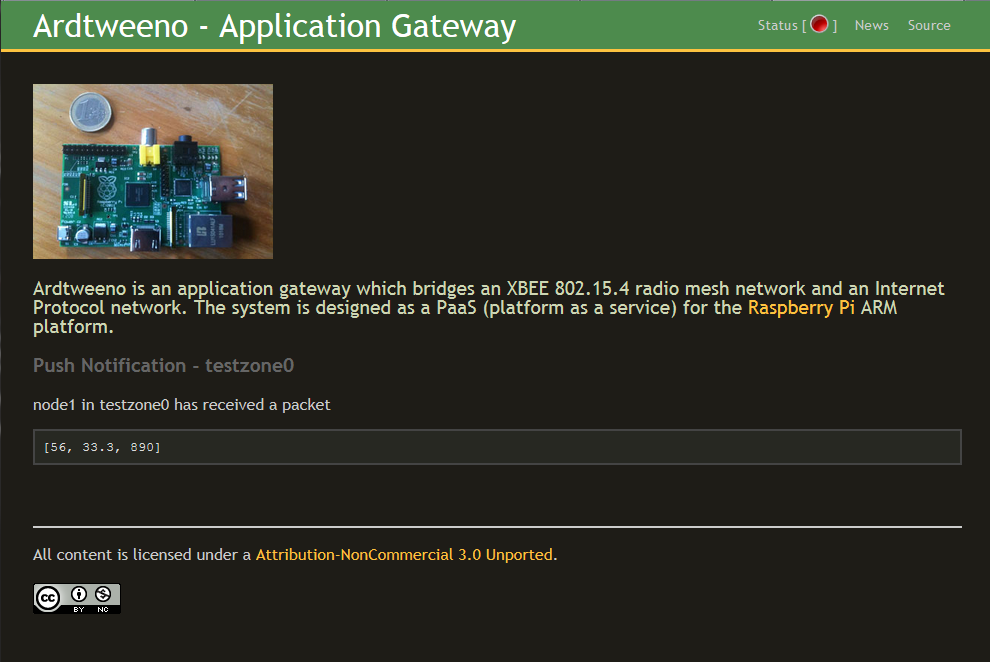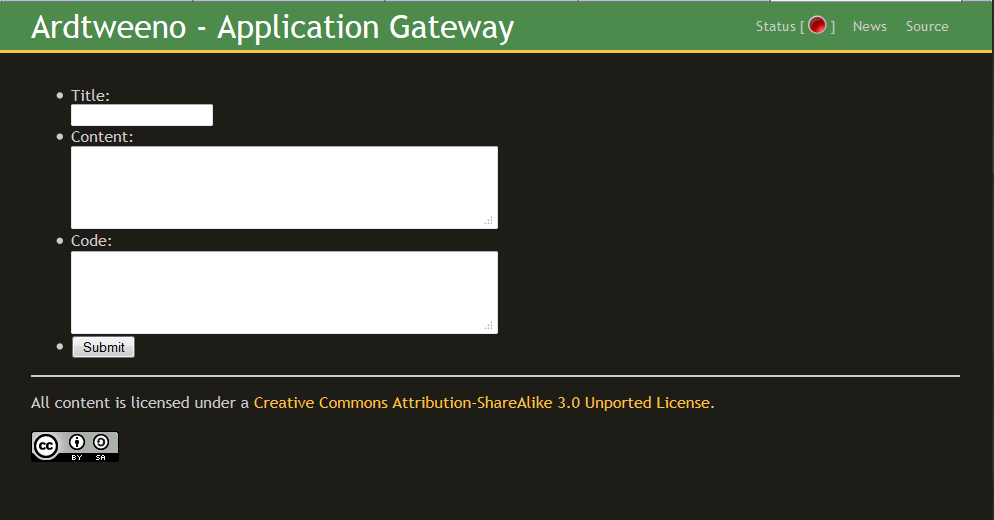-
Notifications
You must be signed in to change notification settings - Fork 0
An Application Programming Interface (API) is the means by which one system may interact with another system and is essentially a machine to machine system interface. The Ardtweeno system exposes this HTTP REST API which can be operated by any device capable of creating HTTP connections to the gateway for this reason. The HTTP REST API is the main interface for working with the Ardtweeno Application Gateway, it allows third parties to develop custom front-ends or data-aggregation systems which interact with the gateway, the REST API allows multiple SerialParser instances to communicate with the gateway from multiple remote locations as the method for adding new data to the gateway is also only possibly by communicating to the Ardtweeno Gateway through the HTTP REST API.
The following HTTP REST API Version 1 set for release with the ER2 product and contains the following features:
-
Add/List packets in the Ardtweeno system
-
List Node data
-
List Zone data
-
Add Node to the Watchlist
-
List system configuration settings
-
Start/Stop the SerialRouter subsystem
-
Restart the gateway host
-
Retrieve current and historical load data for the gateway
URL |
Method |
Function |
/api/v1/nodes |
GET |
Retrieve a list of Nodes. Returns JSON string |
/api/v1/packets |
GET |
Retrieve a list of Packets. Returns JSON string |
/api/v1/packets |
POST |
Add a packet to the Ardtweeno system |
/api/v1/watch/node |
POST |
Add a node to a watch list, and instruct the gateway to update watcher with push notifications |
/api/v1/watch/node |
GET |
Check if a node is being watched {"watched":true|false} |
/api/v1/watch |
GET |
Returns Array of Hash {"node":String, "notifyURL":String, "method":String, "timeout":String} |
/api/v1/zones |
GET |
Retrieve information on zones |
/api/v1/zones/testzone0 |
GET |
Retrieve information on zone testzone0 |
/api/v1/system/start |
GET |
Starts the localhost Ardtweeno SerialRouter |
/api/v1/system/stop |
GET |
Stops the localhost Ardtweeno SerialRouter |
/api/v1/system/reboot |
GET |
Reboots the gateway host |
/api/v1/system/config |
GET |
Read the system configuration file contents |
/api/v1/system/status |
GET |
Read the current system status |
/api/v1/system/status/list |
GET |
Retrieve the last 15 minutes worth of system status data |
/b97cb9ae44747ee263363463b7e56/create/post |
GET |
Access the front page news post form |
/b97cb9ae44747ee263363463b7e56/create/post |
POST |
Add a post to the front end |
All API requests currently require authentication by means of an API key. This key is configured in the /home/user/.ardtweeno/conf.yaml configuration file. This API key must be accompanied with any API calls to the REST API otherwise they will be ignored entirely and return a HTTP 404 response.
key |
/api/v1/packets?key=0dfdFFeeDx |
Return all packets and authenticate with the API key 0dfdFFeeDx |
The following pagination options are available for manipulating the data returned by the API
Parameter |
Sample Usage |
Function |
offset |
/api/v1/packets?offset=50 |
Returns packets excluding the first 50 |
length |
/api/v1/packets?length=50 |
Return the first 50 packets only |
sort |
/api/v1/packets?sort=(desc or asc) |
Return all packets in decending order, defaults to ascending order |
The Packet is the representation of a single piece of information transmitted on the Mesh Network by one of the managed nodes. The packet itself can contain data from one or all sensors attached to an individual node on the mesh network. The HTTP REST API expects data in a specific format otherwise it will be rejected as malformed data. The following JSON objects show the format expected by the HTTP REST API /packets interface when posting a new data packet to the system as a HTTP POST request.
POST /api/v1/packets HTTP/1.1
payload key
The payload parameter must contain JSON data in the format specified below:
Field |
Type |
Description |
key |
string |
The authentication key for this node |
data |
array |
Array of data values, order is important, should match the sensors defined in the sensorlist field inside the corresponding node |
The following is a sample packet in JSON form suitable for the payload parameter.
{
"data": [
25.5,
999,
10.2
],
"key": "authenticationkeyfornode"
}
The key parameter must contain the API authentication key.
NOTE: The API key is different to the node authentication key. One is for gaining access to the REST API, the other is for giving an NODE access to the mesh network
The following is a full example demonstrating how one might work with the API in order to add a Packet to the Ardtweeno Gateway. This is Ruby code and requires the typhoeus gem to be installed and available for use.
require 'rubygems'
require 'typhoeus'
packet = '{"data":[25.5, 999, 10.2], "key":"abcXYZ123etc"}'
apikey = 'abc33fssfe'
Typhoeus::Request.post("http://ardtweeno-hostname/packets",
:body => {:payload => packet, :key => apikey})The Processed Packet contains extra meta data required by the Ardtweeno Application Gateway for each Packet recieved or transmitted on the Mesh Network. Calls to the API to retrieve Packets from the DB using the list interface return JSON as shown below.
GET /api/v1/packets
key
/api/v1/packets?length=2&key=APIkey
{"packets":[{
"date": "2012-11-07",
"hour": 9,
"minute": 36,
"node": "node0",
"key": "0123456789abcdef",
"seqNo": 0,
"data": [
23.5,
997.8,
30
]
},
{
"date": "2012-11-07",
"hour": 9,
"minute": 37,
"node": "node0",
"key": "0123456789abcdef",
"seqNo": 1,
"data": [
25.5,
994.8,
30
]
}],"total":200,"found":2}
The Ardtweeno::Node is the representation of all the information required to manage a physical node on the mesh network. The API offers the means to query the Ardtweeno Application Gateway and retrieve the list of information stored on each node. See below for an example how to interact with the gateway, and the reponse being generated by the gateway. With v1 of the Ardtweeno API specification, the nodes target is read only.
GET /api/v1/nodes
key
/api/v1/nodes?key=APIkey
{"nodes":[{
"name": "node0",
"key": "500d81aafe637717a52f8650e54206e64da33d27",
"description": "This node is outside",
"version": "0.1.0",
"sensors": [
"Temperature",
"Barometric Pressure",
"Altitude"
]
},
{
"name": "node1",
"key": "f937c37e949d9efa20d2958af309235c73ec039a",
"description": "This node is inside",
"version": "0.1.0",
"sensors": [
"Temperature",
"Barometric Pressure",
"Altitude"
]
}],"total":2,"found":2}
The Ardtweeno Application Gateway allows individual nodes to be placed on a watchlist, with the instruction of sending a push notification to the watcher when this node receives packets. This system could potentially be used as an alarm and offers the ability to check the data received from this particular node immediately rather than constantly polling the gateway looking for updates to a particular node.
POST /api/v1/watch/:node
key, node, notifyURL, method, timeout
See the following example to see a node being placed on the watchlist. In this example the Ardtweeno Gateway is running on localhost. The notifyURL parameter is the URL which you wish the Ardtweeno Gateway to notify with a push notification.
require 'rubygems'
require 'typhoeus'
require 'json'
body = {:key=> "1230aea77d7bd38898fec74a75a87738dea9f657",
:notifyURL=>"http://some-server/push/notifications",
:method=>"POST",
:timeout=>"60"}
puts Typhoeus::Request.post("http://localhost:4567/api/v1/watch/node2", :body=>body)
When the gateway sends a push notification it is in JSON format and looks like the following, this push notification system is pre-alpha quality and was rushed in to meet the project deadline. This can be greatly improved in future development.
{
"title":"Push notification",
"content":"node2",
"code":""
}
The Ardtweeno::Node can be grouped into zones by the Ardtweeno Gateway. Zones are a means to assign separate API keys to authenticate and partition groups of nodes from one another. The API offers the means to query the gateway using the HTTP REST API to retrieve information on the nodes and the particular zone they are associated with.
GET /api/v1/zones GET /api/v1/zones/:zonename
key
/api/v1/zones?zonename=testzone0&key=APIkey /api/v1/zones/testzone0?key=APIkey
{
"zones": [
{
"zonename": "testzone0",
"key": "455a807bb34b1976bac820b07c263ee81bd267cc",
"nodes": [
"node0",
"node1"
]
}
],
"total": 2,
"found": 1
}
The following image shows the Ardtweeno HTTP Interface which is powered by the Sinatra micro web application framework. Users who connect directly to the gateway are greeted with this screen.

The ER2 version of Ardtweeno contains URI links to where the source for the system is contained on github.com along with a URI link to my personal blog. A simple status indicator is shown on this page also which shows whether or not the local SerialParser instance is running.
Content for this page can be either added manually using the form available at the http://<ardtweeno-server-address>/<newsURI>/create/post. The newsURI parameter is loaded from the ~/.ardtweeno/conf.yaml file. These front end posts can also be created by creating a HTTP POST request in the following way:

POST /<newsURI>/create/post
title String containing the post title content String containing the post content code String containing code snippets, or preformatted output
See the following for an example
require 'rubygems'
require 'typhoeus'
title = 'Hi This is a Title'
content = 'This is some content lorum ipsum, blah blah etc..'
code = 'require "json"; puts JSON.pretty_generate(
JSON.parse("{'brownfox':'Jumped over the lazy dog'}".to_json)
);'
Typhoeus::Request.post("http://ardtweeno-hostname/packets",
:body => {:title=>title, :content=>content, :code=>code})The output is something similar to the post seen in the image below:
